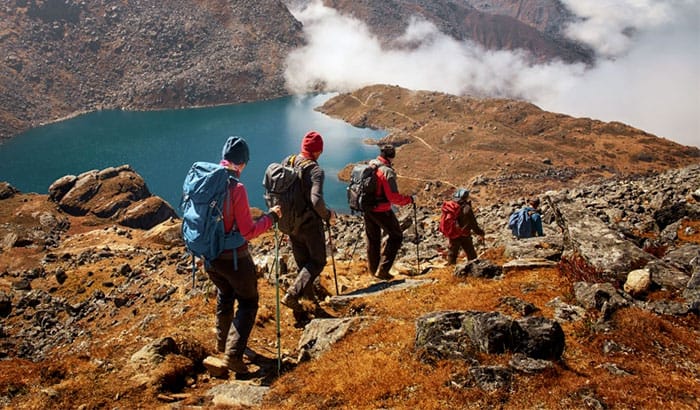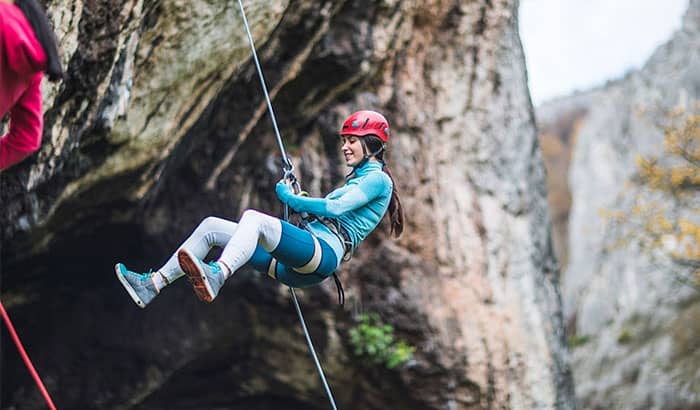If you are still new and trying to learn rock climbing, you have probably asked how do rock climbers get down after the climb? Actually, it is not complicated at all. There are several methods that rock climbers use to go down after the climb. If you want to know what are these methods, read this article and be informed.
Method No. 1: Walking Off
When the climber reaches the top, the climber can easily hike back down to another route to descent. This method is usually done in class 4 route or lower. Normally, if the rock comes with a less steep area, the climber can take advantage of that and just walk off to go down.
This option is also applicable if there are climbing routes that present another decent option where you can easily walk off and go down. The route usually has an option to go down through hiking or walking off towards the base.
Please note that hiking or walking off a rock is one of the easiest and safest ways of getting down. Provided that the route presents this option. But you need to make sure that you are walking off near the cliff while keeping an eye on the original hiking trail if it is available.
Also, ensure that you are properly connected upon cleaning the anchor. Doing a “mini-pitch” to reach safely to the walking terrain. It is also a must to bring a pair of slings that can be used as an anchor if the need arises.
Lastly, walking off can be done if there is an opportunity to do it. It is also the best thing to do when the other methods of going down such as lowering or rappelling will be difficult and dangerous.
Method 2: Lowering
They say that lowering is by far the simplest method for a rock climber to go down after the climb. But, this method is an excellent option if someone else will lead the climb after you. You should also be willing to leave your quickdraws at the top for the use of other climbers when using this method.
Lowering is also recommended for single-pitch climbs which should be up to 30 meters. When it comes to lowering, the climber will end the rope through hardware at the fixed anchor. Then, the climber will have to secure themselves at the end of the rope while letting the belayer help them in going down to the ground through the use of a belaying device.
In the lowering method, you will need a fixed gear that will be installed on a rock or tied to an immovable object such as a tree. You must ensure that this fixed gear is secured and does not move. This method also happens mostly in the gym when someone wants to go down but the gym also has all the systems installed which are different when doing it outdoors.
It is also important to make sure that the half-length of the rope must be longer compared to the fixed anchor you have established at the top. This action will allow the hiker to easily goes down to the ground safely because the rope’s length is exactly what the climbers need when going down.
There are many ways to establish a fixed anchor at the top of the route. It is always important that you have the knowledge to make the anchor once on the top. Make sure that you were taught by experienced and professional hikers before trying to use this method of going down.
Method 3: Rappelling
The main difference between rappelling and lowering is the assistance given by the climber when going down. In lowering, there is someone that helps you go down using a belay device. In rappelling, it is the climber that will lower himself without any form of assistance but still uses fixed anchors while controlling the descent.
In rappelling, the climbing rope is usually threaded to hardware at the fixed anchor. But it is essential that the climber will be threading the rope at the halfway point so that both ends of the rope will reach the next belaying station or in the ground. The climber can use a belaying device to help him get down to the next anchor or the ground.
The belaying device will be used to create friction to manually allow the rope to go through for the climbers to be lowered safely and slowly. You can also rappel on the other side of the rope, but it can be challenging to control and difficult to get the rope down.
Also, in a multi-pitch climb where every member of your climbing team reaches the top, each climber must rappel the rope until the next anchor. Everyone on the team must reach a particular anchor before going down to the next until reaching the ground.
Meanwhile, rappelling in a single-pitch route is usually done when two climbers need to go down or descend. This method is better than lowering since it can carry down to climbers instead of lowering where only one climber will be able to go down.
Method 4: Down Climbing
This method is very unpopular to climbers when going down the ground after the climb. It means you will technically go down the same hat you used during your climb. In a rock climbing environment, this method can be dangerous because the climbers will not see any footholds compared to climbing up.
This method is often used by climbers when practicing in a straightforward route. Those free-soloing climbers can also use this method, but climbers doing this way are experts and know what to do in doing this dangerous stunt. This method will also be used for emergency purposes when an accident or a dropped rope.
Conclusion
Learning how do rock climbers go down is excellent information to have if and when you want to take this sport in the future. There are different ways for a climber to go down once reaching the wall. Each method will be used depending on the situation of the climb as described above.


